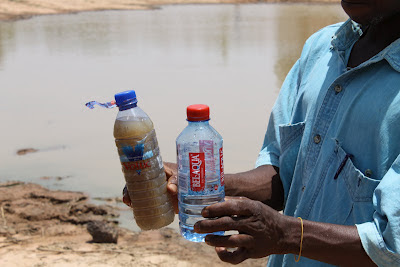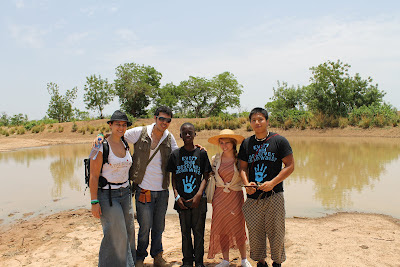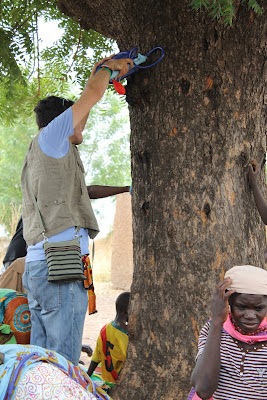Just to give a brief overview... Even in the capital we were not supposed to brush our teeth with the water and were told to 'keep your mouth closed' in the shower. All of our water came from sealed plastic bottles.
The 'sewer' is an open air trough running along side the road. It is not uncommon to see folks stopping and using the bathroom by straddling that sewer. As you get outside the urban areas water running from taps is a luxury very few possess. According to the CIA World Factbook there is very high risk of food and waterborne diseases. According to Water Aid Ghana, 70% of the population does not have access to safe drinking water. In the cities, those who can afford it, buy water in sashays - pictured below. The huge litter problem this creates is a topic for another blog.

A number of aid programs 'help' with a variety of solutions. For example, USAID funded the installation of water collection towers, as did Rotary. As you can see from the photo, USAID's tower doesn't work. The rotary towers actually all seemed to be working - though I didn't get a picture of those.

Digging boar holes and putting in wells are another 'improvement.' Unfortunately, many of these stop working and/or become contaminated. As you can see in the one photo, the tap is padlocked. We were told this happens when they are experiencing a water shortage. They will un-padlock it after they feel the water table has risen enough. Then once it drops, re-padlocking occurs. So, clean water is still not necessarily available consistently.


Most common in the rural areas, up north in Ghana, are the water holes. They are either naturally occurring or 'bowls' built up by the people to collect water when it rains.

One of our community guides filled his empty water bottle with water from the water hole so we could see the contrast with our bottled water. Keep in mind, some of the most dangerous things in that water are invisible to the naked eye.

While just looking at the water hole, we could almost delude ourselves into thinking that people do not in fact drink this water but as if on cue, after most of the students had walked away, this little munchkin came for a 'refreshing' drink.

Women and children walk to these water holes to gather water for cooking in the morning and the evening. If available women use jerry cans or buckets. Some use large bowls. The community we were in used buckets. For our amusement, we got the pleasure of trying to carry this water.


You will notice that the women who have to do this daily do much better than we weaklings do. Some even carry the water with a baby strapped to their back as well.

So, what is a solution you may ask? One small scale solution is a water filter. There are a number of for-profit companies that produce filtration systems that clean the water for individual families. We had the pleasure of visiting one such company, called Vestergaard Frandsen. They produce the Life Straw and Life Straw Family.

A number of our students (pictured below with our bus driver's son) fundraised more than $1,000 to purchase some of these filters to take to one of our partner communities.

The students taught the community leaders how to use the filters.
 First step is to hang the filter, as gravity is key.
First step is to hang the filter, as gravity is key.

Dirty water goes in the top. Clean water comes out the bottom.
With the Queen Mother (leading lady in the community) getting the first taste of the clean water.

Though, all were soon enjoying some clean water (you can see the difference with the bottle of dirty water in my student's hand. She was having the kids point to which bottle had the 'better'/ safer water).


The women even tried out the filter, since it will be their job to use it in the home.

For less than $30, dirty life-threatening water...

Is transformed to clean, safe water.

I leave you with one of the best PSA's I think I have ever seen - as this brings the issue of clean water to your kitchen. Think about it next time you drink from the tap, brush your teeth with that water, or fill a pot to cook your dinner and thank your lucky stars for the safe water that runs from your tap.
Correction - the non-working tower was a USAID/Rotary Partnership. This was the only non-working of many Rotary projects we saw, therefore, they still outshine others in the field.
ReplyDelete